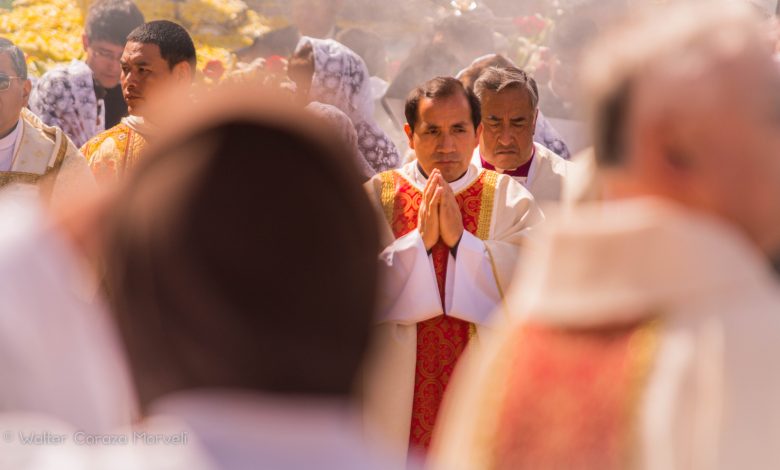Corpus Christi and Religious Change in Cuzco

Corpus Christi is one of the two great celebrations of the Catholic liturgical calendar that draws in the people of Cuzco. The feast itself is grand and draws processions of the traditional saints from Cuzco’s historical neighborhood churches. The occasion is redolent with incense but also with sound and with the impact of history and of social change.
During this occasion, which in Cuzco carries a uniqueness in the Catholic world, its is worth looking at the situation of religion in Cuzco and Peru. In much of Latin America Catholicism is becoming a voluntary identity, a personal and relatively unimportant characteristic, something removed from belonging to society in its whole. Massive feasts, such as Corpus Christi, involving the whole of a population and tightly organized around the bases that organize local society are weakening if not disappearing.
The 2007 census of Peru included a question on religious membership. If we look at those numbers we notice Something very interesting in this light. It seems that the Department of Cuzco is bucking the trend. It is more Catholic, as of the time of this census, than the country as a whole (86% to 81%). It is also more Catholic than nearby departments of the Peruvian South with the exception of Arequipa.
This situation should give one pause to ask why Cuzco diverges from these other departments. Though that question should take us into comparative depth with each of the neighboring departments (and hence beyond the scope of this note) we can look closer at Cuzco to see if there are answers there.

Within the Department we see differences within the different provinces. Anta, Acomayo and Cusco stand at one extreme ( 90%, 88%, and 87%) while the rest of the provinces have lower percentages of Catholics.

This suggests that the province which contains the city of Cuzco is more Catholic than the rest of the department, outside of those two provinces. In the province of Cusco, the most Catholic district is Santiago, whose patron saint paraded around the city’s main square. It is 88% Catholic, while Cuzco district is 87%, and San Jeronimo song with San Sebastian are at 86%. Wanchaq, another populous district is also 86% Catholic.
Cuzco is a place with an unusually strong concentration of Catholics. As a result, it makes sense to see the massive number of people who participate in the feasts of Corpus Christi and its pair, the feast of the Lord of Temblors during Holy Week.
Both depend on strong brotherhoods and sisterhoods, confraternities, organized around the city’s saints which also maintain a relationship to hierarchies of social status and economic benefit within the city.
While this is still the case, we can also see in the numbers its weakening. Other ways of living and being, as well as developing status and social position, are developing in the city that do not require participation in the civic religious organization of Catholicism.

For example, Peru’s census provides numbers of Evangelicals, as well as members of other faiths (mostly Seventh-day Adventists, Jehovah’s Witnesses, and Mormons) as well as of people who claim no religion. With one exception, these numbers are weaker in Cuzco than in the country as a whole, however the category of Other is stronger in Cuzco than in Peru as a whole.
This stands out. Of course, while numbers of Evangelicals are growing and are some three times those of Other, none the less these faiths claim inroads and are probably developing status hierarchies and connections making for alternative means of becoming someone within Cuzco’s urban society, especially for people who are middle class or wish to be.
As we saw in an earlier post, Cuzco’s society has also experienced substantial out-migration and in-migration. Both of these would tend to weaken the system of hermandades, the confraternities. This system could easily break down even if the numbers of Catholics remain high.
The strength of Corpus Christi and of the Lord of Temblors suggest that confraternities remain valuable within Cuzco society, but they should not blind us to changes within Cuzco’s Catholicism besides simply conversion to other faiths or to the status of none.

The religious field is changing and within it we see changing options for Catholics as well. I have heard people talk about how they only believe in God and reject the saints. Not only is this a rejection of the power of these holy figures it is also a rejection of feasts, feast sponsorships, and confraternities. People talk about how difficult it has been to extract themselves form the system of feasts but how important such an action was for them personally and for their family economy even though they remain Catholic.
There also is within the city a rejection of Catholicism for what is called Andean religion.
The Saints and their confraternities remain a center of Cuzco’s life, but changes are happening along the edges that might lead to radical transformation in the not so distant future. Already it has been almost eight years since the last census. Future measures are likely to see increased changes along the lines of those we have seen here.
For now Corpus Christi is strong and powerful. It moved the society deeply.




